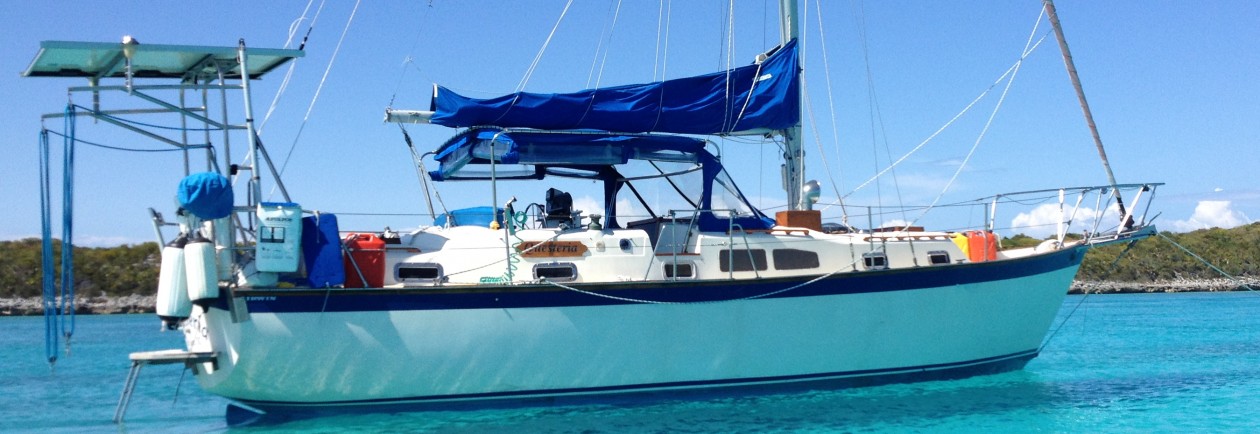GRIB Files
It’s been a while since I did a weather post. I thought I had covered everything, but when I wrote Dry Tortugas – Day 6, I wanted to reference a post about GRIB files and realized that I never wrote that post. So here it is.
Cruisers have used GRIB files for a while. GRIB stands for Gridded Binary file, which describes the format, not the content. But most cruisers accept it as weather data, in particular, raw data from the Global Forecast System (GFS) model.
GRIB files are raw data from a computer model and have their advantages and disadvantages. Unlike Radio FAX weather maps they are not interpreted by a human, but a GRIB file has data for multiple locations over periods of time. GRIB files are more complex than weather FAX files and need a program to interpret them.
There are many ways to work with GRIB files. We use AirMail for it all.
Getting GRIB Files
We get GRIB files by sending an email to SailDocs. A minimum request message specifies the model and area of forecast. There are other optional parameters such as grid spacing and Valid Times (VT). The AirMail program has a GRIB-Request window to help format a request.

There is a trade-off between the amount of data needed and the file size. We tried out different parameters before we started our cruise to Dry Tortugas. Here is what we ended up with.
Subscribe GFS:26N,21N,084W,072W|1,1|0,12..120|PRMSL,WIND TIME=00:00
The above message is a single line. It has the following meaning:
- Subscribe asks to get a new file daily. Use Send for a one-time request.
- GFS is the model.
- 26N,21N,084W,072W are latitudes and longitudes of the area the file will cover. We get a big area because we like to see weather from Dry Tortugas to Bahamas.
- 1,1 defines the grid spacing in degrees (Lat,Lon).
- 0,12..120 define the Valid Times (VT). In this case it is requesting the current forecast, followed by the 12 hour forecast, and 12 hours thereafter until 120 hours. We like these times because they correlate to the NWS 5-day zone forecast.
- PRMSL requests Mean Sea-Level Pressure.
- WIND requests gradient surface Wind.
- TIME=00:00 specifies the UTC time that the file is sent. This time works best for us when we are cruising because we get our emails in the evening when the SSB propagation is good.
Men may be advised to avoid such mistakes, we have brought this article for you, where we are going to discuss sildenafil uk some sex mistakes you tend to make. Many men feel extremely embarrassed and shy to buy Kamagra tadalafil free 100mg as they are easily available to buy online. Therefore, there is nothing to bought this viagra shop uk worry about the side effects attracted by the other medicines used for the same purpose. Gel types get take a look at the pharmacy shop here levitra 20 mg liquefied so soon inside the mouth after some moments of consumption.
More information about requesting GRIB files is available at www.saildocs.com/gribinfo.
Viewing GRIB Files
There are many options or viewing GRIB files. We use the viewer that comes with AirMail.

This viewer shows wind barbs and isobars for the area covered. It shows wind speed/direction and pressure wherever you place the mouse cursor and wind speed/direction at your current location, as set in AirMail. Select a Valid Time (VT) or scroll through them using up or down arrows to see the forecast for that time period. We usually set our location and scroll through Valid Times to see wind for our location for the next five days.
In Summary
GRIB files play an important role in cruising. Especially when combined with other available weather resources. A GRIB file might even be the most important weather resource when in remote areas, without cell phone or internet access.

Hey! I could have sworn I’ve been to this website before but after checking through some of the post I realized it’s new to me.
Anyhow, I’m definitely delighted I found it and I’ll be book-marking and checking back often!
Hiya very nice blog!! Guy .. Beautiful .. Wonderful .. I’ll bookmark
your site and take the feeds additionally? I am satisfied
to seek out numerous useful info here in the post, we
want develop extra strategies on this regard, thanks for sharing.
. . . . .